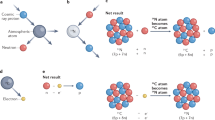Abstract
THE release of 14C in nuclear explosions, particularly those detonated in 1961–1962, has caused a major disturbance of the steady-state natural distribution of this radioisotope. The resultant pulse of bomb 14C, detected initially in the atmosphere, has since been used extensively in evaluation of rates of exchange of carbon between major reservoirs of the dynamic cycle — notably atmospheric CO2 and ocean water bicarbonate1–7. Within the biosphere, however, investigation of human 14C levels has been more limited despite the application of bomb 14C as early as 1959 by Broecker and co-workers8 in the determination of residence times of carbon in several tissues. Perhaps the most specific result to emerge from initial research on this topic was the demonstration of almost total inertness of collagen in the adult human skeleton as evidenced by its failure to incorporate significant amounts of artificial 14C (ref. 9). In other related 14C measurements10–13, a non-correspondence between contemporary human and atmospheric 14C levels was often observed. Nydal and co-workers proposed a combination of three factors to account for such variations13 and concluded from a long term analysis of 14C concentrations in human blood and hair samples that bomb 14C enters the human body 1.4 years after production in the atmosphere, and remains there with a mean lifetime of 10 years. This article describes the continuation at Glasgow of an intensive investigation of the presence of bomb 14C in humans, initiated by Harkness and Walton12. Comparison by these workers of blood plasma protein 14C data with predicted dietary 14C levels14 has confirmed that a finite turnover of carbon in the human body does exist. Here, determination of 14C activities of atmospheric CO2, dietary and human tissue samples enables a more detailed evaluation of residence times.
This is a preview of subscription content, access via your institution
Access options
Subscribe to this journal
Receive 51 print issues and online access
$199.00 per year
only $3.90 per issue
Buy this article
- Purchase on Springer Link
- Instant access to full article PDF
Prices may be subject to local taxes which are calculated during checkout
Similar content being viewed by others
References
Bien, G. & Suess, H. E., Radioactive Dating and Methods of Low-level Counting 105–115 (I.A.E.A., Vienna, 1967).
Münnich, K. O. & Roether, W., Radioactive Dating and Methods of Low-level Counting 93–104 (I.A.E.A., Vienna, 1967).
Nydal, R., Radioactive Dating and Methods of Low-level Counting 119–128 (I.A.E.A., Vienna, 1967).
Young, J. A. & Fairhall, A. W., J. geophys Res. 73, 1185–1200 (1968).
Walton, A., Ergin, M. & Harkness, D. D., J. geophys Res. 75, 3089–3098 (1970).
Rafter, T. A. & O'Brien, B. J., Proc. 8th Int. Radiocarbon Conf. New Zealand 8, C17–C37 (1972).
Gulliksen, S. & Nydal, R., Proc. 8th Int. Radiocarbon Conf. New Zealand 8, C58–C72 (1972).
Broecker, W. S., Schulert, A. & Olson, E. A., Science 130, 331–332 (1959).
Libby, W. F., Berger, R., Mead, J. F., Alexander, G. V. & Ross, J. F., Science 146, 1170–1172 (1964).
Nydal, R. & Löuseth, K., Nature 206, 1029–1031 (1965).
L'Orange, R. & Zimen, K., Naturwissen 55, 492 (1968).
Harkness, D. D. & Walton, A., Nature 223, 1216–1218 (1971).
Nydal, R., Lövseth, K. & Syrstad, O., Nature 232, 418–421 (1971).
Harkness, D. D. & Walton, A., Nature 240, 302 (1972).
Stenhouse, M. J. & Baxter, M. S., Radiocarbon 18, 161–171 (1976).
Farmer, J. G., Stenhouse, M. J. & Baxter, M. S., Radiocarbon 14, 326–330 (1972).
Broecker, W. S. & Olson, E. A., Radiocarbon 3, 176–204 (1961).
Jansen, H. S., Proc. 8th Int. Radiocarbon Conf. New Zealand 8, F1–F26 (1972).
Baxter, M. S. & Walton, A., Proc. R. Soc. Lond. A 321, 105–127 (1971).
Tauber, H., Radiocarbon 9, 246–256 (1967).
Stenhouse, M. J. thesis, Univ. Glasgow (1975).
Spiers, F. W., Radiosotopes in the Human Body (Academic, New York and London, 1968).
Eggen, D. A. & Solberg, L. A., Lab. Invest. 18, 571–579 (1968).
Kaplan, J. A., Cox, G. E. & Taylor, C. B., Arch. Pathol. 76, 359–368 (1963).
Ho, K. J., Taylor, C. B. & Biss, K. in Atherosclerosis, Proc. 2nd Int. Symp. Chicago 271–273 (1969).
Schoenheimer, R., The Dynamic State of Body Constituents (Harvard University Press, Cambridge, Mass 1942).
Neuberger, A. & Richards, F. F. in Mammalian Protein Metabolism, I 243–296 (Academic, New York and London, 1964).
Zilversmit, D. B. in Atherosclerosis, Proc. 2nd Int. Symp. Chicago 35–41 (1969).
Kao, K. Y., Hilker, D. M. & McGavack, T. H., Proc. Soc. expt. Biol. Med. 106, 121–124 (1961).
Author information
Authors and Affiliations
Rights and permissions
About this article
Cite this article
STENHOUSE, M., BAXTER, M. Bomb 14C as a biological tracer. Nature 267, 828–832 (1977). https://doi.org/10.1038/267828a0
Received:
Accepted:
Published:
Issue Date:
DOI: https://doi.org/10.1038/267828a0
This article is cited by
-
The risk of leukaemia in young children from exposure to tritium and carbon-14 in the discharges of German nuclear power stations and in the fallout from atmospheric nuclear weapons testing
Radiation and Environmental Biophysics (2014)
-
Stable carbon isotope ratios in Asian elephant collagen: implications for dietary studies
Oecologia (1992)
-
Tritium concentration in foods and human tissues: Estimation of mean residence times of organically-bound tritium in costal cartilage and sternum
Journal of Radioanalytical and Nuclear Chemistry Articles (1992)
-
Possible future trends of radiation exposure by carbon 14
Radiation and Environmental Biophysics (1982)
-
Problems of the radiation hazard of14C
Soviet Atomic Energy (1980)
Comments
By submitting a comment you agree to abide by our Terms and Community Guidelines. If you find something abusive or that does not comply with our terms or guidelines please flag it as inappropriate.



